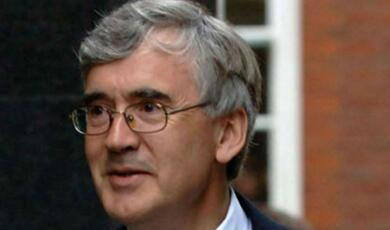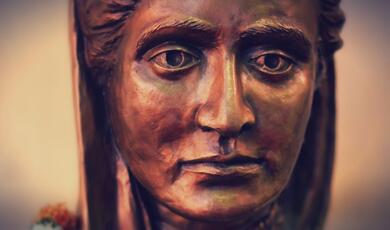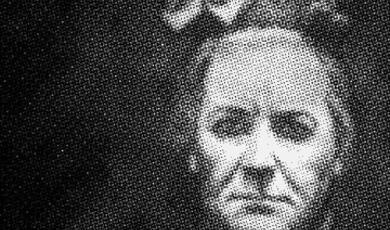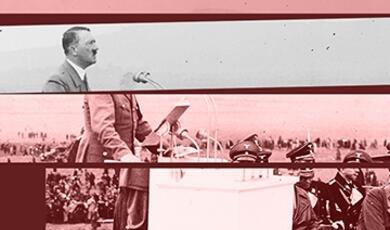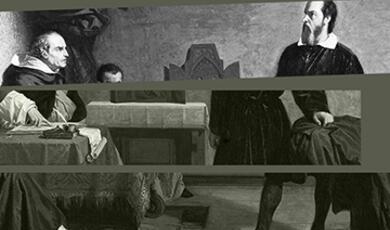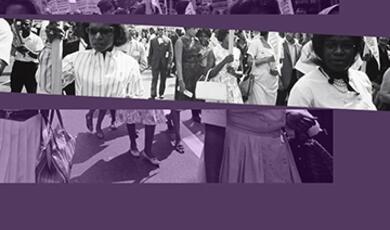Segregation and the Rule of Law
Share
- Details
- Transcript
- Audio
- Downloads
- Extra Reading
The law has been used to entrench and uphold racial prejudice, most infamously in South Africa during the apartheid years, but also in the United States in the period up to the mid-twentieth century. In South Africa and the southern states of America, judges showed themselves willing to use the law to uphold and promote white supremacy.
This lecture will discuss the uneasy interplay between the concept of the rule of law and the enforcement of segregation legislation.
Download Transcript
Segregation and the Rule of Law
Professor Thomas Grant QC
21st March 2022
I want to start with a building. Pretoria is one of the capitals of South Africa and in 1898 its Jewish Community erected a beautiful new Synagogue. Here it is in 1904; a magnificent blend of the Gothic, the Moorish and the Byzantine. For more than 50 years the Jewish citizens of Pretoria worshipped here. They then decided that the building had become too small to fit their congregation. In 1952 the building was purchased by the state and was converted into a Courthouse, with the intention that it would deal with special “security cases.” For over twenty years, as I will discuss, many of the significant clashes between dissenters and the state took place in this building.
Four years before the Old Synagogue was purchased, the National Party had formed a government, after its surprise success in the general election of 1948, an election comprised almost exclusively of white voters. It had swiftly instituted its programme of apartheid – literally “separateness” – what one National Party prime minister described, without trace of irony, as “simple good-neighbourliness.” The abysmal rhetoric of the time was “separate but equal.”
Apartheid was a social and political programme based on racial ideas which now revolt us, but to work in practice it had to have a legal underpinning. After 1948 a tide of legislation ensued, emanating of course from an all-white Parliament, and in short order the building blocks of the apartheid state were laid.
So, in 1950 the Population Registration Act provided for the formal, individual classification of every South African into one of three racial categories (described as ‘white’, ‘native’ and ‘coloured’). It is deeply discomforting to see how the bland language of parliamentary statute dealt with and implemented a policy of naked racism. So we find the following definitions in the Act:
- “‘white person’ means a person who in appearance obviously is, or who is generally accepted as a white person, but does not include a person, who although in appearance obviously a white person, is generally accepted as a coloured person.”
- “‘native’ means a person who in fact is or is generally accepted as a member of any aboriginal race or tribe of Africa.”
- “‘coloured person’ means a person who is not a white person or a native.”
The Act descended further down the rabbit hole. For instance in deciding whether a person was “obviously white” the Act said that “his habits, education and speech, and deportment and demeanour shall be taken into account.” Just think about all the racial assumptions that that provision allowed to be brought to bear by the bureaucrats charged with its implementation.
A person’s racial categorisation mattered and would affect in a profound way every aspect of that person’s life, whether it was economic, social, political or personal. Where there was doubt about a person’s racial categorisation humiliating and absurd tests could be deployed to work out into which racial group they supposedly fitted. One technique was the so-called pencil test; if a pencil was pushed into a person’s hair and it did not fall out that was seen as an indicator that they were a so-called “native”. A person was permitted to challenge their classification and there was introduced a so-called Race Classification Appeal Board, constituted by a tribunal of 3 persons chaired by a judge. It heard literally thousands of cases. And sometimes it was not the person who had been classified who was trying to overturn their classification. Third parties were also permitted to challenge a person’s designation and there were examples of a person’s classification as white being questioned by an anonymous challenge, thereby setting into motion the machinery for a witch hunt into the racial history of an individual. So we see immediately how the law and segregation were inextricably entwined.
As I have said a person’s racial classification mattered. For instance, if you were registered as a coloured or native person then you could not marry a white person. Under the Prohibition of Mixed Marriages Act 1949 it was illegal for a so-called “European” to marry “a Non-European”. Not only were you committing a crime if you entered into an inter-racial marriage but, to quote the statute, such a union “shall be void and of no effect.”
A little later the Immorality Act 1957 outlawed any form of “unlawful carnal intercourse” between the races. Again let’s look at how this prohibition translated into actual legal language:
“16. (1) (a) Any white female person who—
(i) has or attempts to have unlawful carnal intercourse with a coloured male person; or
(ii) commits or attempts to commit with a coloured male person any immoral or indecent act; or
(iii) entices, solicits, or importunes any coloured male person to have unlawful carnal intercourse with her; or
(iv) entices, solicits or importunes any coloured male person to the commission of any immoral or indecent act…
shall be guilty of an offence.”
You may have noted that in this statute the word “native” or “black” is not used. This is because the phrase “coloured person” had been defined in this Act as “any person other than a white person.” Legislators had various methods of defining racial difference. The maximum sentence for an offence under section 16 was 7 years in prison. Throughout the 1960s and 70s there were several hundred prosecutions a year under this statute.
Statutes such as these prohibited inter-racial marriage or sexual relations were by no means confined to South Africa at this period. Most of the states of America had similar legislation. You may recall the famous case decided by the United States Supreme Court in 1967, Loving v Virginia. One of the key differences between the United States and South Africa at the time was the existence in America of a written Constitution against which the legality of statutes could be judged. No judge in South Africa could simply refuse to apply the provisions of – for instance - the Immorality Act because they disagreed with it. The fact of a parliamentary democracy – albeit in South Africa a perverse form of democracy - carries with it the possibility of terrible legislation.
On the other hand in the Loving case the Supreme Court held that a Virginian statute prohibiting inter-racial marriage violated the Equal Protection and Due Process clauses of the Fourteenth Amendment. The aptly named Mr and Mrs Loving had married in 1959 and the judge who sentenced them to a year in prison said the following. Remember this was 1959, not 1759:
“Almighty God created the races white, black, yellow, malay and red, and he placed them on separate continents. And, but for the interference with his arrangement, there would be no cause for such marriage. The fact that he separated the races shows that he did not intend for the races to mix."
No South African judge could say, even if they privately thought it, what Chief Justice Earl Warren wrote in the decision in the Loving case: “the freedom to marry has long been recognised as one of the vital personal rights essentially to the orderly pursuit of happiness by free men” – though one would like to replace that word “men” with “people” now.
In a less well known decision McLaughlin v Florida, decided 3 years earlier in 1964, the Supreme Court had struck down a Florida statue which made it an offence for a white and black person who were not married to “habitually live in and occupy in the night time the same room.” There two of the members of the court had said that they could not “conceive of a valid legislative purpose . . . which makes the color of a person's skin the test of whether his conduct is a criminal offense."
The Acts I have so far referred to are just the tip of the legal iceberg created by apartheid South Africa. The Extension of University Education Act 1959 created a system of totally segregated universities. Nelson Mandela had attended the University of Witwatersrand in the late 1940s. Under apartheid that was no longer possible: it was now an all-white institution. The Reservation of Separate Amenities Act 1953 permitted the segregation of all public premises, vehicles and services. And of course in order to be enforceable it had to criminalise. So section 1 provided:
“(2) Any person who wilfully enters or uses any public premises or public vehicle or any portion thereof or any counter, bench, seat or other amenity or contrivance which has in terms of sub-section (1) been set apart or reserved for the exclusive use of persons belonging to a particular race or class, being a race or class to which he does not belong, shall be guilty of an offence and liable on conviction to a fine not exceeding fifty pounds or to imprisonment for a period not exceeding three months, or to both such fine and such imprisonment.”
The Group Areas Act 1950 restricted the places in which black or coloured people – to use the language of the period - were permitted to live or work. Under an anodyne title this terrible piece of legislation mandated the forcible removal of tens of thousands of non-white families from their homes to segregated areas. The most notorious of these was the mass eviction of the coloured population of District Six in Cape Town, close to Table Mountain, after it was designated a so-called “white area”. A whole town was then destroyed and rebuilt for new white residents.
By the deceptively named Natives (Abolition of Passes and Co-ordination of Documents) Act 1952 a system was instituted whereby every black person over the age of 16 had to be fingerprinted and furnished with a reference book that contained various information about him or her. A police officer could at any time call upon that person to produce his reference book; failure to produce it on demand constituted a criminal offence, punishable by up to one month in prison. The passes were, as you may well understand, hated by the black population.
It will be obvious that the effect of these laws was to criminalise whole swathes of ordinary human activity. A black person who did sat in a whites-only part of a restaurant was committing a crime. A black person who swam off a beach designated for whites was committing a crime. A black person who sat on a part bench designated for whites was committing a crime. And so across the country notices appeared dictating behaviours and expressly or implied threatening its majority inhabitants with prosecutions. Here are some of the signs that people in South Africa confronted in their daily life.
All these laws had to be administered. The effect of such a deluge of legislation was to place the courts, and mainly the criminal courts, at the centre of the administrative structure of apartheid. In order to maintain this institutional segregation infractions of the rules that created it had to be prosecuted and vigorously so. In one year alone in the mid-1970s there were over 380,000 prosecutions under the pass laws.
The South African courts had enjoyed a very high international reputation throughout the first half of the twentieth century. South Africa’s legal system was closely modelled on an amalgam of the English common law and Roman-Dutch law. It had a long tradition of respect for the rule of law. And the judges who now found themselves having to administer the new apartheid justice were not simply stooges of the system. In my last lecture I discussed the administration of criminal justice in the Soviet Union and during the Third Reich. Criminal justice in those countries was largely a charade. That was not the case in South Africa. The courts continued to function and as far as the state was concerned the rule of law persisted. This presents a conundrum about the concept of the rule of law, whether it is purely procedural, or whether it involves substantive rules. The paradox was identified the philosopher, Joseph Raz, in famous book as follows:
“A non-democratic legal system, based on the denial of human rights, on extensive poverty, on racial segregation, sexual inequalities, and religious persecution may, in principle, conform to the requirements of the rule of law better than of an of the legal systems of the more enlightened Western democracies…it will be an immeasurably worse system, but it will excel in on respect: in its conformity to the rule of law….The law may institute slavery without violating the rule of law.”[1]
It has been remarked that South Africa during this time presented a paradox. The apparatus of apartheid, and the ever more oppressive and draconian laws enacted to maintain the subjugation of the black population, meant that South Africa acquired the hallmarks of a police state. Torture and extra-judicial killing was widely practised by state operatives. Yet, at least for some part of the rule of the National Party, the country’s legal system remained largely intact, most of its judges stayed broadly independent and its procedures preserved at least the semblance of fairness. The respect for the rule of law which South Africa had shown in the first half of the century did not simply wither after 1948.
Despite that standing the courts were obliged to apply the apartheid legislation which then flooded the statute books. Some judges did their best to blunt its full sting. But as we have seen the Courts lacked the legal power to strike down unconstitutional laws. And all too often the judges seemed to show a craven passivity in the face of monstrousness. In my first lecture I discussed some of the fundamental attributes of what is known as the rule of law. I referred to some of the principles of the rule of law which travel wider than Professor Raz’s narrow conception. These are overarching principles concerning liberty and judicial oversight which, although they cannot be deployed to set aside parliamentary statutes, can be used as interpretative devices to make legislation so far as possible consistent with the principles of the rule of law. But what we see time and again during the apartheid period is judges putting them aside to give full reign to what they discerned as the legislative intent of the apartheid state.
Take this notorious example. In the late 1950s a proclamation issued under the Group Areas Act divided the city of Durban into exclusive areas for whites and those of Indian background. A number of Indians challenged the proclamation on the basis that the zoning resulted in substantial inequality of treatment for the Indian group which was not expressly permitted by the Act. On appeal the Appellate Division acknowledged that the Group Areas Act did not expressly permit inequality of treatment but was willing hold that it was implied. So one of the judges said this:
“The Group Areas Act represents a colossal social experiment and a long term policy. It necessarily involves the movement out of Group Areas of numbers of people throughout the country. Parliament must have envisaged that compulsory population shifts of persons occupying certain areas would inevitably cause disruption and, within the foreseeable future, substantial inequalities. Whether all this will ultimately provide to be for the common weal of all the inhabitants is not for the court to decide.” [2]
As one commentator wrote about this decision: by a reference to what Parliament “must have envisaged” the court gave its blessing to a gigantic population removal scheme that resulted in untold human sorrows.[3] It chose an interpretation which, as it was well aware, would have serious human consequences.
There is a further paradox. The law reports of this period are crammed full of reasoned and learned discussions – written in measured legal language very familiar to lawyers in England – of legislation which seems to emerge from a nightmare. It is as if two worlds are colliding together but the judges are too polite to mention it. Let me give three examples:
- In 1959 Godfrey Pitje, a lawyer employed by the firm of Mandela and Tambo refused on principle to take his seat at a separate table for black practitioners in a magistrate’s court. He was convicted of contempt of court. He appealed and the Chief Justice in refusing that appeal said: “it is clear that a practitioner would in every way be as well seated at the one table as at the other and that he could not possibly have been hampered in the slightest in the conduct of his case by having to use a separate table.” He drew comfort from the fact that under the Reservation of Separate Amenities Act the courtroom could have been segregated.[4]
- In 1963 Albie Sachs, who later survived an assassination attempt and went on to become a judge of the constitutional court, was arrested. He was held in detention under a recent law that allowed for detention of a person for up to 90 days without charge and without access to a lawyer. He asked for reading and writing materials; the police who were holding him denied them. He brought a claim seeking to confirm that this deprivation was unlawful. The relevant statute was silent on the question and it was for the court to fill the gap, as so often. The normal principle is that where a statute departs radically from fundamental principles of law the legislature is presumed not to have intended to make further inroads on individual liberty than those provided for. That was not the way the appeal court saw the matter: they divined in the legislation that Parliament had not intended that such people should be allowed “to relieve the tedium of their detention with reading matter or writing materials.” The judges decided that one of the purposes of the lengthy period of detention was to encourage the detainees to give information. That purpose was blunted if they could spend the time reading or writing. “The interests of the individual must sometimes yield to the interests of the state.”[5]
- In a final case a man called Ivan Schermbrucker was arrested and held incommunicado under the same provision under which Albie Sachs had been held. Word got out to his wife that he was being interrogated in a brutal way. She filed an application for an injunction to prevent this treatment. The police denied the allegation. Mrs Schermbrucker therefore sought an order that her husband be produced to the court for him to give evidence personally. You would have thought that a court would in no circumstances decide that a person should not be permitted to testify before them. Yet it was held that there was no such power: the legislation permitting incommunicado detention was there to act as an “inducement to speak”; that would be negatived by permitting a detainee to give evidence concerning his own detention.[6]
What these examples show is that outside the precise wording of Acts of Parliament there are wide tracts of judicial discretion. The courts could have applied substantive principles of the rule of law to constrain interference with human liberty. Instead it chose to zealously apply the perceived policy of the Acts to carry further their effects. That is how the culture of a country can change.
As the years went by South Africa’s judges were increasingly hand-picked by the government on the basis of political affiliation. Nonetheless a former minister of justice could still ruefully comment that these state placemen, once safely installed on the bench, quickly came to convince themselves that they had been appointed on merit alone, and acted accordingly. Although the law was distorted so that it became a caricature of basic concepts of fairness, it was still possible (with capable and determined representation) to obtain at least the semblance of a fair trial. When I say a fair trial I mean generally a trial before a judge. Although jury trial was abolished in 1969 black defendants would rarely opt for it before then. Only white people could sit on juries and most black defendants felt, with good reason, that they were better off in the hands of a white judge then a white jury.
As you will all recall the apartheid regime generated many dissenters who worked to resist and undermine it. Throughout the 1950s the ANC instituted a series of peaceful protest campaigns. This led to one of the most remarkable trials of the twentieth century, the so-called Treason Trial, in which 150 of the leading members of the ANC and the South African Communist Party were prosecuted for treason by allegedly plotting the overthrow of the state by violence. This was the authorities’ bold attempt to destroy in one swipe the anti-apartheid leadership. The list of the defendants is a roll-call of the great names of the resistance movement: Nelson Mandela, Walter Sisulu, Helen Joseph, Ahmed Kathrada, Joe Slovo.... The total length of the legal proceedings lasted five years and the trial itself ran for almost three years.
And it takes us back to where I started, the Old Synagogue in Pretoria. From 1958 to 1961 Mandela and his co-defendants had to travel there from their homes in Johannesburg to sit in court day after day. The court house now looked very different to the photograph I showed you at the beginning of this lecture. The Ten Commandments had been boarded up. Everywhere the trappings of segregation were present. There were separate entrances for “Europeans” and “Non-Europeans”. The public gallery, lavatories and waiting rooms were all similarly divided on racial lines. The one place where there was no apartheid was the witness stand: the trial allowed Mandela and many other black leaders a platform to speak both to the judges and to the wider world about their values and ideals.
There were so many oddities about this trial; the prosecutor, Oswald Pirow, had been a minister of justice in the 1930s and had visited Hitler twice. He remained an admirer of the Fuhrer and was an ardent exponent of racial segregation. Yet here he was in a former place of Jewish worship. The defence counsel were all white – the only black advocate in South Africa Duma Nokwe at the time was himself one of the accused – and many of them were Jewish, whose fathers or grandfathers had fled prejudice in Russia or Eastern Europe and were now fighting a different type of prejudice in South Africa. One of them was Sydney Kentridge, then in his mid-30s, and who turns 100 this year. He was sent anonymously during the trial photographs taken illegally from the public gallery. Here they are: There is a grainy immediacy about them but they also bring to a life another fact about South African justice at this time: unlike in the Soviet Union or Nazi Germany there remained a vigorous and independent legal profession willing to provide representation to those perceived as enemies of the state. They also reveal something about the nature of the justice. This was a proper trial, not a sham proceeding.
The Treason Trial is not so well known as the later trial which took place from 1963-1964, the so-called Rivonia Trial, in which Mandela and his co-defendants were convicted and sentenced to life imprisonment. This is because the defendants at the earlier trial were all acquitted. And this takes me to back to the paradox that South Africa presented at the time: there were three judges presiding at this trial, all white and two closely associated with the government. They heard month upon month of evidence which, so the prosecution said, revealed that the ANC and its leadership were bent on provoking violent insurrection. The judges knew that this was a political trial instituted by the government for a clear purpose. Yet they were true to their judicial oaths and delivered not guilty verdicts.
Here are two wonderful photographs with the Old Synagogue in the background: first here is Nelson Mandela displaying his extraordinary charisma even when on trial for his life. And second, here is Isie Maisels QC, the lead counsel for the Treason Trial defendants, being carried out of court in triumph after their collective acquittal in March 1961. And if you look closely you can see the entrance provides “Non-Europeans Only.” Maisels had chosen to come out of that entrance.
The second case at the Old Synagogue I wanted to mention takes us 10 years further forward. Nelson Mandela is now in prison on Robben Island. His wife Winnie has taken up the mantle of the freedom struggle. The state strikes again against her and 21 other alleged members of the ANC. She is arrested in 1970 under the recently enacted section 6 of the Terrorism Act. Let me read it out to you. It is one of the heinous pieces of legislation. It permitted a police officer:
“ if he has reason to believe that any person who happens to be at any place in the Republic, is a terrorist or is withholding from the South African Police any information relating to terrorists or to offences under this Act, [to] arrest such person or cause him to be arrested, without warrant and detain or cause such person to be detained for interrogation at such place in the Republic and subject to such conditions as the Commissioner [of the South African Police] may, subject to the directions of the Minister, from time to time determine, until the Commissioner orders his release when satisfied that he has satisfactorily replied to all questions at the said interrogation or that no useful purpose will be served by his further detention…”
Crucially, two later subsections provided that:
- “No court of law shall pronounce upon the validity of any action taken under this section, or order the release of any detainee.”
- “No person, other than the Minister or an officer in the service of the State acting in the performance of his official duties, shall have access to any detainee, or shall be entitled to any official information relating to or obtained from any detainee.”
For many months Winnie Mandela was kept in detention under this section; she was kept in total isolation for much of that time and intermittently tortured. In her memoir entitled 491 Days, the total period of her incarceration, she vividly conveys the nightmare. She was completely cut-off from the world, from her lawyers, family and friends.
Section 6 abrogated some of the most fundamental attributes of what we think of as the rule of law. It deprived a person of judicial oversight, access to lawyers, or a fixed period of detention. That phrase until the Commissioner is satisfied that “no useful purpose will be served by his further detention” essentially allows for unlimited detention. It has been pointed out that it was only the passivity of the judges in relation to earlier parliamentary provisions – examples of which I have already given - which emboldened Parliament to go this far. It is an example of how the judiciary can create a climate where certain things can become acceptable.
Yet when she finally came on for trial in the Old Synagogue Winnie Mandela was acquitted by a white Afrikaner judge of the actual charges against her.
The final case I am going to talk about was the inquest of the black activist Steve Biko. Many of you will remember that Biko was one of the leaders of the black consciousness movement of the 1970s; a man of courage and vision who would surely have been a key figure in a post-apartheid South Africa. He was beaten to death. There followed an inquest which took place in November 1977. It lasted 13 days and through the cross-examination of Sydney Kentridge, the various police officers and doctors who had come into contact with Biko in the days and hours up to his death were revealed to be callous liars and in some cases obviously responsible for the violent assault on Biko which led to his death. The Magistrate, tasked with making findings as to the circumstances of Biko’s death set out his conclusions in a two minute judgment. Having recorded Biko’s name, age and the date of his death, the Magistrate said the following:
“The available evidence does not prove that the death was brought about by any act or omission involving or amounting to an offence on the part of any person. That completes this inquest.”
This was a perverse verdict and revealed the extent to which the South African judiciary had begun to dishonour their oaths. Biko’s widow left the Old Synagogue and was heard to say, over and over again, “No one to blame?”.
But the paradox is present again; although Biko’s inquest had failed to yield the right result, and was a grotesque miscarriage of justice, nonetheless its process had been largely fair. It had been conducted in an open court room attended by the world’s press, who could freely report it; the principal figures had been subjected to intense cross-examination. Kentridge had been by and large able to put whatever questions he wished and to call the witnesses he wished to call. The result was that through the inquest the world woke up to the iniquities of the apartheid regime. The Biko Inquest succeeded on a much more profound level and revealed how court processes can sometimes be more important than court verdicts.
The Biko Inquest was the last substantial case to be heard at the Old Synagogue. Soon after its conclusion the building was turned over to more banal government activities. It fell into disuse in 1995 and, although it was declared a national monument in 1999, the Old Synagogue has endured a long and sad decline since. Various suggestions have been made over the years to repurpose the building for cultural or educational uses; none have come to pass. Today it still stands, boarded up and crumbling, white-washed in a bland ministry of works cream, surrounded by a razor wire fence, a symbol of an era of oppression and tragedy but also of resistance and hope.
© Professor Grant, 2022
[1] The Authority of Law (1979, OUP), pp 211-212.
[2] Holmes JA, Minister of the Interior v Lockhat 1961 (2) SA 587 (AD).
[3] John Dugard, Human Rights and the South African Legal Order (Princeton UP, 1978), p.320
[4] R v Pitje 1960 (4) SA 709
[5] Rossouw v Sachs,1964 (2) S.A. 551(A.D.)
[6] Schermbrucker v Klindt NO 1965 (4) SA 606 (AD).
Part of:
This event was on Mon, 21 Mar 2022
Support Gresham
Gresham College has offered an outstanding education to the public free of charge for over 400 years. Today, Gresham plays an important role in fostering a love of learning and a greater understanding of ourselves and the world around us. Your donation will help to widen our reach and to broaden our audience, allowing more people to benefit from a high-quality education from some of the brightest minds.


 Login
Login




